Nyheter
Emerging Markets Bonds Continue To Rally
Publicerad
8 år sedanden
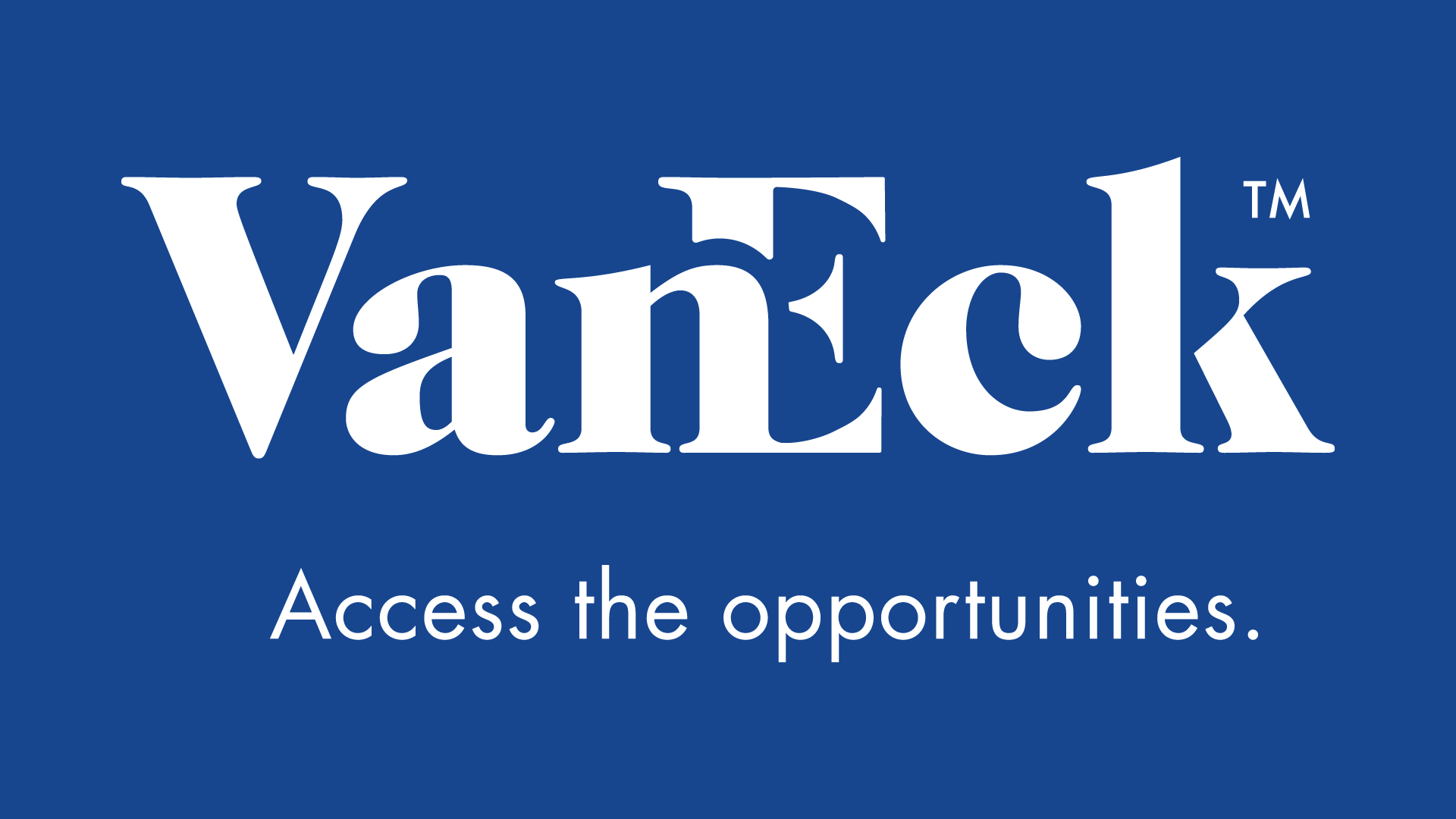
The overwhelming influence of G-3 (U.S., Japan, and Europe) monetary policy has been the dominant theme in emerging markets debt this year, and September was no exception. U.S. interest rate volatility leading up to the Federal Reserve (the “Fed”) meeting impacted hard currency bonds, while local currency sovereign bonds were boosted by stronger currencies and lower local interest rates. Overall, accommodative policies and contained inflation continue to provide support, and all sectors of emerging markets debt produced positive returns in September. Emerging Markets Bonds Continue To Rally.
Rate Volatility and Curve Steepening
Interest rate volatility was a primary concern in September as the market grappled with the possibility that the major developed market central banks might be on the verge of policy shifts. The European Central Bank and the Bank of Japan versions of quantitative easing are both under review and the anticipated impact of reversals or tapers led to steeper curves. In the U.S., the Fed remained on hold, as expected, but took a more hawkish tone with regard to the likelihood of a single hike before yearend. Even so, the scaled back rate expectations of Fed governors in the “dot plot” showed only two potential hikes in 2017.
Emerging Markets Credit Developments
Amid the focus on developed market central bank actions, there were several notable credit stories in emerging markets. After the political events of the summer, Turkey lost its investment grade status following a downgrade by Moody’s Investors Service. Some forced selling of Turkish hard currency sovereign bonds will likely occur due to its removal from investment grade indices at the end of October. Hungary, by contrast, regained investment grade status following an upgrade by Standard & Poor’s (S&P), which may support additional inflows in coming months. Turkish spreads widened while spreads on Hungarian sovereign bonds tightened. We continue to have conviction in higher quality hard currency sovereign bonds, and believe they can offer an attractive yield pickup versus core investment grade fixed income sectors, without excessive risk.
On the corporate side, Petroleos de Venezuela S.A. (PDVSA) was downgraded further into junk territory by S&P following the announcement of a proposed debt swap that could be characterized as a distressed exchange. Although a successful swap would buy time by reducing 2017 maturities, clearly the PDVSA and sovereign bonds continue to price in a very high risk of default with yields ranging between 15% and 50% (annualized for shorter maturity bonds in the latter case). The high current yields on the bonds coupled with a price recovery this year as Venezuela continues to apply band aids to its longer term structural problems, have made the country a top performer in the hard currency space year-to-date. In addition, Brazil’s Petróleo Brasileiro S.A. (Petrobras) announced a new spending plan through 2021 that aims to regain investment grade status by reducing leverage, primarily through an ongoing asset sale program.
The mixed ratings actions, and more generally the mixed data through the month reflect the economic diversity within emerging markets. There were inflation upside and downside surprises in September, and although Mexico hiked rates many emerging markets central banks currently appear to favor further easing. Both Indonesia and Russia cut rates, and Brazil may be poised for rate cuts later this quarter. Overall, the fundamental picture in emerging markets continues to brighten, given that real GDP growth is expected to recover this year to 3.9% and further accelerate in 2017, and current account balances are improving as exports increase.
Strong Local Currency Performance As Rates Remain Steady
Returns in the emerging markets debt space have so far in 2016 ranked commensurately with risk. More specifically, local debt has been the top performer, with a total return of 17.08% YTD after a very strong September (2.02%). Although local sovereigns are lower duration by nearly two years versus U.S. dollar sovereigns, currency risk has tended to be a major factor in volatility and returns (though currency movements explain only about 40% of this year’s return through the end of September). Hard currency corporate debt has actually lagged hard currency sovereign debt, but when one considers the greater than two year duration difference between the asset classes in a year when U.S. Treasury yields have moved significantly lower, the performance difference makes sense. In both the sovereign and corporate hard currency space, high yield has performed significantly better than investment grade.
South Africa, Colombia, and Russia were the top performing countries in the local space, while the Philippines, Mexico, and Malaysia posted negative returns, mostly on currency weakness. In contrast to most emerging markets currencies, the Mexican peso has depreciated 11% against the U.S. dollar. In addition to sluggish economic growth, much of the weakness has been attributed to the upcoming U.S. presidential election and the consequences of a potential Trump presidency. Further volatility is possible over the next month.
Hard currency bonds were impacted by U.S. rate movements in the first half of the month, but generally recovered by month end. Sovereign bonds returned 0.40%, with many of the riskier names outperforming as a result of both spread tightening and a lower duration versus higher quality issuers, which were more impacted by the steepening of the yield curve. The same was true for corporate bonds, which finished September with a small positive return overall (0.18%) while the high yield segment returned 1.14% for the month. Emerging markets high yield bonds yielded 0.51% more than U.S. high yield bonds at the end of September, and provided a pickup of 80 basis points in option-adjusted spread terms. The spread advantage tightened 20 basis fallen angels points during the month, driven largely by an influx of Turkish bank “fallen angels” entering the BofA Merrill Lynch Diversified High Yield US Emerging Markets Corporate Plus Index (EMLH or the “Index”). Although these bonds are tighter than the rest of the overall Index, we believe these bonds are trading at spreads that are attractive for BB rated bonds.
Looking Ahead: December Rate Hike Coming into Focus
As we enter the fourth quarter, given the significant gains in emerging markets debt already achieved this year, one might ask: Where do we go from here? Near term uncertainty will likely come from the approaching U.S. elections, the continued positioning of Organization of Petroleum Exporting Countries (OPEC) members and the resulting impact on oil prices, and the precarious capital positions of some European banks. Most significantly, the prospect of a December rate increase in the U.S. will increasingly come into focus. However with a liquidity backdrop that is still very supportive, yields that remain attractive, and fundamentals that continue to improve, we believe that the investment case for emerging markets debt is not likely to be diminished with the next rate hike.
September 2016 1-Month Total Returns by Country
(Click to enlarge) Source: FactSet as of 9/30/2016. Not intended to be a forecast of future events, a guarantee of future results or investment advice. Current market conditions may not continue.
RELATED FUNDS
VanEck VectorsTM ETFs
CBON
ChinaAMC China Bond ETF
EMAG
Emerging Markets Aggregate Bond ETF
EMLC
J.P. Morgan EM Local Currency Bond ETF
HYEM
Emerging Markets High Yield Bond ETF
IGEM
EM Investment Grade + BB Rated USD Sovereign Bond ETF
IHY
International High Yield Bond ETF
VanEck Funds
EMBAX
Unconstrained Emerging Markets Bond Fund: Class A
Fran Rodilosso Head of Fixed Income ETF Portfolio Management
Portfolio Manager for Fixed Income ETFs
Oversees the Fixed Income ETF team; responsible for portfolio strategies, as well as credit and market analysis; specializes in international bond markets
Investment Management Team member since 2012
Prior to joining VanEck, Managing Director of Global Emerging Markets with The Seaport Group; launched the firm’s emerging markets fixed income sales and trading business
Previously held portfolio management positions at Greylock Capital and Soundbrook Capital; focused on corporate high-yield and distressed bonds with an emphasis on emerging markets
Earlier career experience includes senior fixed income trading positions at Credit Lyonnais and HSBC
Quoted in Financial Times, Barron’s, and ETF Trends, among others
CFA charterholder; member of New York Society of Security Analysts
MBA (with distinction), Finance, The Wharton School of Business, University of Pennsylvania; AB, History, Princeton University
Du kanske gillar
-


XEMC ETF investerar i klimatförändrare i emerging markets
-


ETF från Amundi på Xetra ger brett diversifierad exponering mot företag från utvecklade och tillväxtmarknader
-


EL40 ETF en återinvesterande fond som satsar på emerging markets
-


4UBL ETF investerar i emergings market, men inte i Kina
-
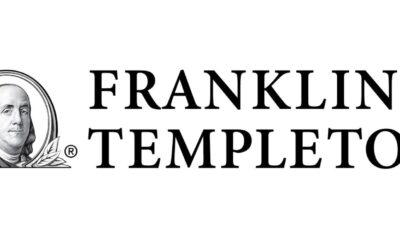

Ozempic can’t help your overweight in big tech: Global ETF diversification ideas for 2024
-


Mexikos silverproduktion minskar tvåsiffrigt för första gången på nästan ett decennium.
Nyheter
XEMC ETF investerar i klimatförändrare i emerging markets
Publicerad
45 minuter sedanden
2 maj, 2024
Xtrackers MSCI Emerging Markets Climate Transition UCITS ETF 1C (XEMC ETF) med ISIN IE000DNSAS54, försöker spåra MSCI Emerging Markets Select Sustainability Screened CTB-index. MSCI Emerging Markets Select Sustainability Screened CTB-index spårar aktier från tillväxtmarknader över hela världen. Värdepapperen är utvalda och viktade enligt hållbarhetskriterier och EUs direktiv om klimatskydd. Moderindex är MSCI Emerging Markets.
Den börshandlade fondens TER (total cost ratio) uppgår till 0,19% p.a. Xtrackers MSCI Emerging Markets Climate Transition UCITS ETF 1C är den enda ETF som följer MSCI Emerging Markets Select Sustainability Screened CTB-index. ETFen replikerar det underliggande indexets prestanda genom fullständig replikering (köper alla indexbeståndsdelar). Utdelningarna i ETFen ackumuleras och återinvesteras.
Denna ETF lanserades den 26 september 2023 och har sin hemvist i Irland.
Indexbeskrivning
MSCI Emerging Markets Select Sustainability Screened CTB Index syftar till att spegla resultatet på följande marknad:
– Stora och medelstora företag i globala tillväxtmarknadsländer som väljs ut och viktas i syfte att uppfylla minimistandarderna för EU:s CTB
– Minska exponeringen för utvalda indikatorer som anses ha negativ miljöpåverkan eller social påverkan, och öka exponeringen mot företag som bidrar positivt till samhället och miljön
– ESG-undantag
– Granskas halvårsvis
Handla XEMC ETF
Xtrackers MSCI Emerging Markets Climate Transition UCITS ETF 1C (XEMC ETF) är en europeisk börshandlad fond. Denna fond handlas på flera olika börser, till exempel Deutsche Boerse Xetra och London Stock Exchange.
Det betyder att det går att handla andelar i denna ETF genom de flesta svenska banker och Internetmäklare, till exempel DEGIRO, Nordnet, Aktieinvest och Avanza.
Börsnoteringar
| Börs | Valuta | Kortnamn |
| London Stock Exchange | USD | XEMC |
| XETRA | EUR | XEMC |
Största innehav
| ISIN | Namn | Vikt % | Land | Sektor |
| TW0002330008 | TAIWAN SEMICONDUCTOR MANUFACTURING | 6.98 % | Taiwan | Informationsteknologi |
| KR7005930003 | SAMSUNG ELECTRONICS LTD | 4.16 % | Sydkorea | Informationsteknologi |
| KYG875721634 | TENCENT HOLDINGS LTD | 4.00 % | Kina | Kommunikationstjänster |
| KYG017191142 | ALIBABA GROUP HOLDING LTD | 2.54 % | Kina | unknown |
| INE002A01018 | RELIANCE INDUSTRIES LTD | 1.46 % | Indien | Energi |
| KYG596691041 | MEITUAN | 1.10 % | Kina | Sällanköpsvaror |
| INE090A01021 | ICICI BANK LTD | 0.94 % | Indien | Finans |
| US7223041028 | PINDUODUO ADR REPRESENTING INC | 0.93 % | Cayman Islands | unknown |
| KR7000660001 | SK HYNIX INC | 0.91 % | Sydkorea | Informationsteknologi |
| CNE1000002H1 | CHINA CONSTRUCTION BANK CORP H | 0.91 % | Kina | Financials |
| INE009A01021 | INFOSYS LTD | 0.89 % | Indien | Informationsteknologi |
| TW0002454006 | MEDIATEK INC | 0.80 % | Taiwan | Informationsteknologi |
| KYG6427A1022 | NETEASE INC | 0.70 % | Kina | Kommunikationstjänster |
| SA0007879113 | AL RAJHI BANK ORD | 0.67 % | Saudiarabien | Finans |
| KR7005931001 | SAMSUNG ELECTRONICS NON VOTING PRE | 0.62 % | Sydkorea | Informationsteknologi |
Innehav kan komma att förändras
Nyheter
Regulatory Crackdowns and Ethereum’s Most Anticipated Application
Publicerad
23 timmar sedanden
1 maj, 2024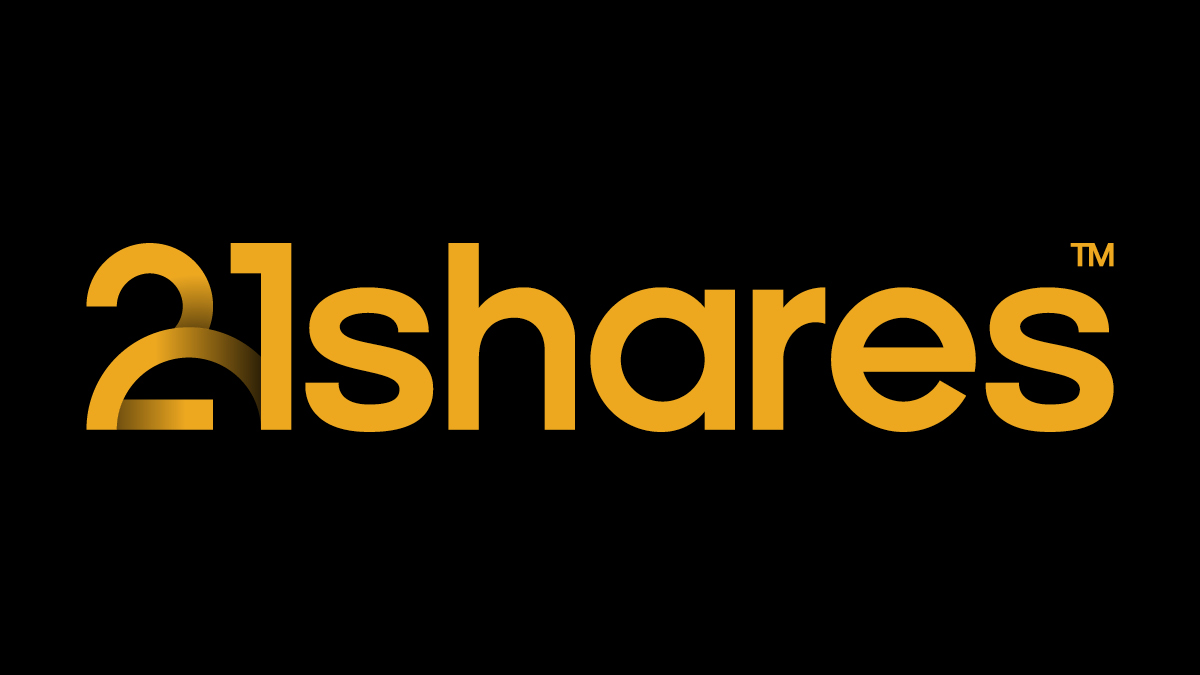
• Regulatory Crackdowns Fire Up in April
• Macro Uncertainty, Geopolitical Headwinds, and Bitcoin’s Fourth Halving
• The Arrival of Ethereum’s Most Anticipated Application
Macro Uncertainty, Geopolitical Headwinds, and Bitcoin’s Fourth Halving
April brought a challenging landscape for Bitcoin. Geopolitical tensions flared in the Middle East when Israel targeted the Iranian Consulate in Syria on the 1st of April. In an unprecedented response, Iran retaliated directly with a drone strike against Israel, intensifying hostilities. The event contributed to a decline in the stock market and a temporary pullback in Bitcoin’s price. As mentioned two weeks ago, although Bitcoin historically served as a safe haven during crises like the Russian Invasion of Ukraine, its response to Iran-Israeli escalation may have been adverse.
However, a closer look at the market reveals a more nuanced picture. The impact on Bitcoin was primarily felt in the futures market, where open interest peaked at $35 billion on the day of the Consumer Price Index (CPI) print, leading to significant liquidations when inflation came in hotter than expected for the fourth month running. Resilience in the labor market, coupled with strong domestic demand, is evidence that despite Fed efforts, the US is not yet in a position for rate cuts, which may pose further turbulence for risk-on assets. Encouragingly, long-term holders demonstrated resilience amidst escalating tensions. Unlike short-term fears reflected in futures markets, long-term holders increased their supply by 0.1% over the past week, for the first time since January, as the Israeli response seemingly coincided with a local bottom for long-term holder supply. This is a bullish signal, showcasing belief in the asset, irrespective of recent market activity. Nevertheless, we can see that BTC will continue to be stuck in the $60K – $70K range until we get more clarity on the macroeconomic and geopolitical front.
Figure 1: Bitcoin Short-Term Holder Supply vs. Long-Term Holder Supply
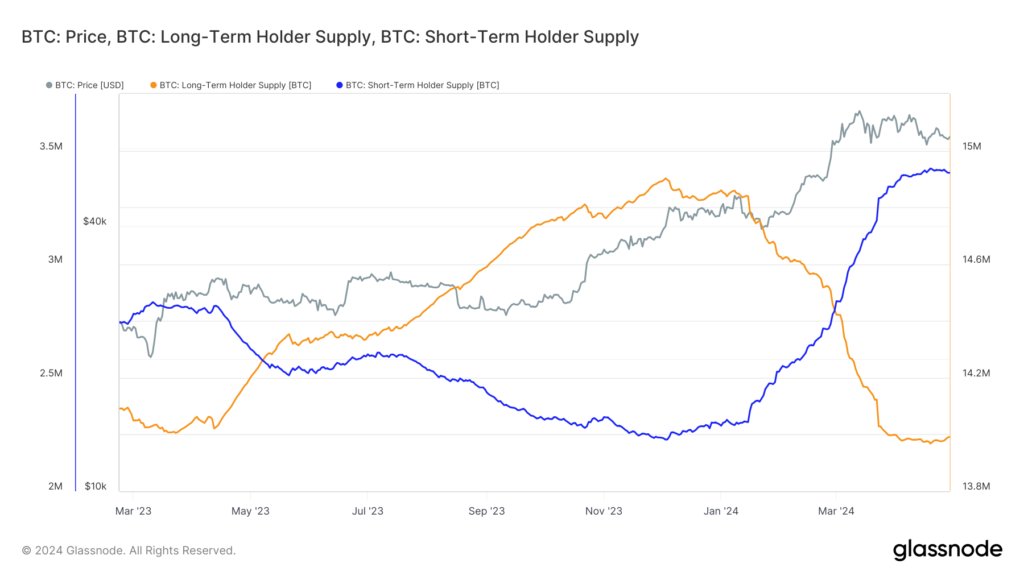
Source: Glassnode
Despite the macroeconomic headwinds, significant progress was made in the institutional adoption of Bitcoin. Despite a break in Blackrock’s Bitcoin ETF 71-day net inflow streak, the conclusion of the 90-day due diligence period for fund managers considering the spot ETFs revealed that over 100 institutions, such as BNY Mellon and Banco do Brazil, are exposed to Bitcoin. Morgan Stanley is also actively exploring allowing 15,000 brokers to provide this exposure to their clients. They also filed to broaden access to BTC ETFs by expanding it to 12 more funds, signifying the growing acceptance of Bitcoin by TradFi institutions. Finally, the launch of Bitcoin ETFs in Hong Kong marked a significant step towards adoption in Asia, potentially influencing other jurisdictions like South Korea, Japan, and Singapore to follow suit while expanding Bitcoin’s access to Hong Kong’s $1.15 trillion wealth management sector.
Beyond the market’s activity, April also marked a historic event for Bitcoin: the fourth halving, reducing Bitcoin’s annual inflation rate to below 1%, making it even scarcer than Gold. Historically, Bitcoin trades 50% down from its peak leading up to the halving. This year, Bitcoin defied historical trends, reaching a new all-time high prior to the halving, attributed to the surge in demand from the aforementioned US Bitcoin ETFs, coupled with ongoing technical advancements within the Bitcoin ecosystem, such as Ordinals, BRC-20s, and Runes, as touched upon in the last newsletter.
These advancements are transforming Bitcoin beyond its original vision as a purely decentralized payment network. The emergence of Ordinals and Runes has amplified on-chain activity, reflected in surging transaction fees. This is particularly beneficial for Bitcoin miners, who saw their block reward cut in half due to the halving. Higher transaction fees help compensate for this lost revenue, ensuring the continued security of the Bitcoin network. Notably, as shown in Figure 2, Bitcoin transaction fees made up 75% of Bitcoin miner revenue, soaring to $128 on the day of the halving. While the surge might have been driven by the desire to have a historical inscription, it does underscore the potential impact on miners’ revenue as Bitcoin’s on-chain ecosystem matures.
Figure 2: Bitcoin Miners Revenue
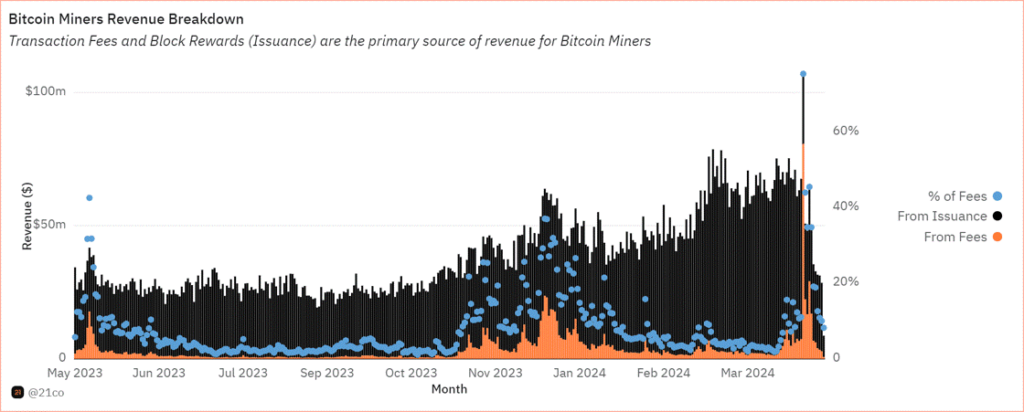
Source: 21.co on Dune
Launched in April, Runes Protocol offers a novel approach to creating fungible tokens on the Bitcoin network. It addresses inefficiencies associated with the BRC-20 standard, which have burdened the Bitcoin blockchain due to its inefficient data handling. Ultimately, Runes presents a key innovation that bolsters Bitcoin’s security budget by offering miners an alternative source of revenue, while reducing their dependence on block rewards. Runes has already rewarded miners with almost $150 million, impressively making up 80% of fees generated on the Bitcoin network on April 23, as shown below.
Figure 3: Share of Bitcoin Transaction Fees
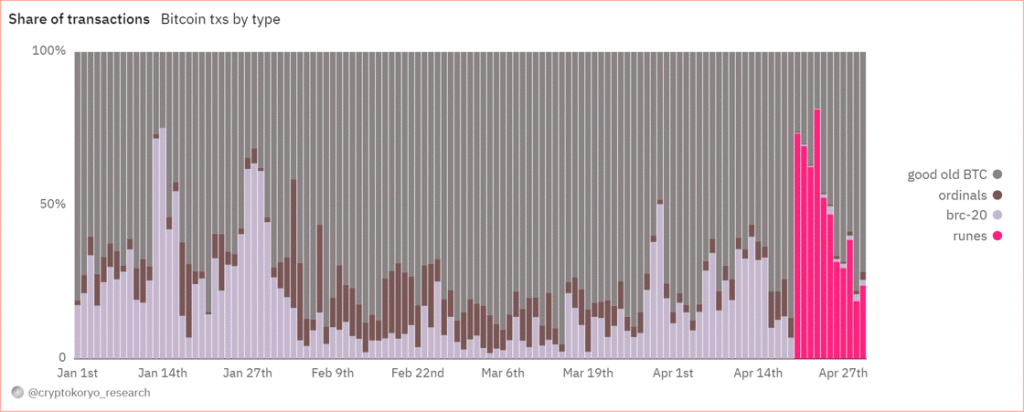
Source: CryptoKoryo on Dune
While Bitcoin’s daily transaction volume surpassed 1 million, rivaling Ethereum’s activity, the initial excitement surrounding Runes might recede before a more long-term, sustainable surge in the network’s DeFi activity. The initial phase often focuses on meme-like tokens attracting rapid but fleeting interest. However, the development of sophisticated DeFi protocols like exchanges and Automated Market Makers (AMMs) will enhance Bitcoin’s application layer, streamlining token trading similar to what ERC-20/ERC-721 standards did for Ethereum. This paves the way for a more robust and mature DeFi ecosystem on Bitcoin, which we will closely monitor in the months to come.
Regulatory Crackdowns Fire Up in April
April saw the continued regulation-by-enforcement trend, cracking down on non-custodial infrastructure and the Ethereum ecosystem. On April 10, the Securities and Exchange Commission (SEC) sent Wells Notices to Uniswap and Consensys for alleged violation of federal securities law. Uniswap announced its intention to resolve this through court. The details of the SEC’s Wells Notice remain unclear. However, it could have been triggered by Uniswap’s pending revenue-sharing initiative, which has had a domino effect on the ecosystem. In the short term, the crackdown could dissuade protocols from following suit, which would have incentivized their users to stake and delegate their tokens for a share of the revenue.
On April 25, Consensys filed a lawsuit against the SEC for “unlawful seizure of authority,” arguing that Ethereum is not a security nor that MetaMask is a securities broker. The recent crackdown could put a strain on the crypto infrastructure industry in the short term, as it could severely disrupt the ecosystem while encouraging companies to explore alternative jurisdictions aside from the U.S. market.
Earlier in February, the SEC adopted rules that widened its interpretation of a dealer to include “as part of a regular business” in addition to the initial definition, “any person engaged in the business of buying and selling securities . . . for such person’s own account through a broker or otherwise.” The newly adopted rules have now triggered an outcry in the crypto community, deeming the legislation too broad, as it includes average market participants in cryptoasset liquidity pools (liquidity providers), who essentially have a very different role than a broker.
For example, liquidity providers on Uniswap can be anyone, given they have the capital to deposit and earn yield, unlike professional market makers in traditional finance whose responsibilities extend beyond that. Providing liquidity on Uniswap is open to anyone to enable permissionless markets, which makes this an important characterization due to the impact it could have on how DeFi functions in the US. While the ongoing crackdown could cause uncertainty in the short term within the Ethereum ecosystem, regulatory clarity will ultimately be reached in the long run, as we’ve seen on several counts of hurdles over the past few years.
Ethereum’s Most Anticipated Application of the Year is Live
EigenLayer is finally live on Ethereum’s mainnet. It’s a new primitive that allows ETH users to “re-stake” their existing staked ETH to validate the security of external networks. EigenLayer has been eagerly anticipated as it optimizes capital efficiency by allowing users to earn additional yield on top of their native staking rewards. Further, it allows younger protocols to borrow the security assurances of Ethereum, circumventing the need to bootstrap their own security from scratch. This translates to a more cost-efficient approach while simultaneously bolstering their decentralization. Nevertheless, the protocol comes with inherent risks.
By opting to earn additional yield, users, and validators subject themselves to heightened smart contract risks as they become exposed to the vulnerabilities of both Ethereum and the additional protocols relying on its security. Moreover, a large portion of ETH could end up being “re-staked” in EigenLayer instead of just validating the security of Ethereum, creating a problem of misalignment. Simply, some validators might opt to maximize their profits by pursuing strategies that prioritize short-term gains over the long-term security of the network. Additionally, the growing enthusiasm for the protocol suggests that a significant portion of the crypto economy might rely on Ethereum’s security. Currently, 15% of all staked ETH is allocated towards Eigen’s re-staking strategy. The continuation of this trend could lead to centralization, posing a risk as Ethereum might inadvertently become a single point of failure over a longer time horizon.
Wide-spread slashing is another concern. In essence, if a substantial amount of ETH is re-staked in a singular protocol, then a slashing event due to unintended or malicious behavior could significantly impact honest ETH stakers. Thus, Eigen proposed a slashing committee comprising esteemed ETH developers and trusted community members, empowered to veto such occurrences and safeguard Ethereum’s integrity.
The final risk concerns a new breed of tokens known as Liquid re-staking Tokens (LRTs), which operate atop EigenLayer. LRTs, akin to Liquid Staking Tokens (LSTs) issued by the established Lido Protocol in 2021, aim to unlock similar capital efficiency by allowing users to use their re-staked ETH as collateral for lending and borrowing. Given that re-staked ETH in Eigen can’t be used across DeFi platforms, users have turned to LRT protocols like Ether.fi and Renzo to seek higher levels of capital flexibility, with their re-staked assets. For context, LRTs grew exponentially by a factor of 28 throughout Q1, increasing from nearly 100K units to the current figure of 2.8M, as shown in Figure 4, illustrating its soaring demand.
Figure 4: Growth of Liquid re-staking Tokens (LRTs) on EigenLayer
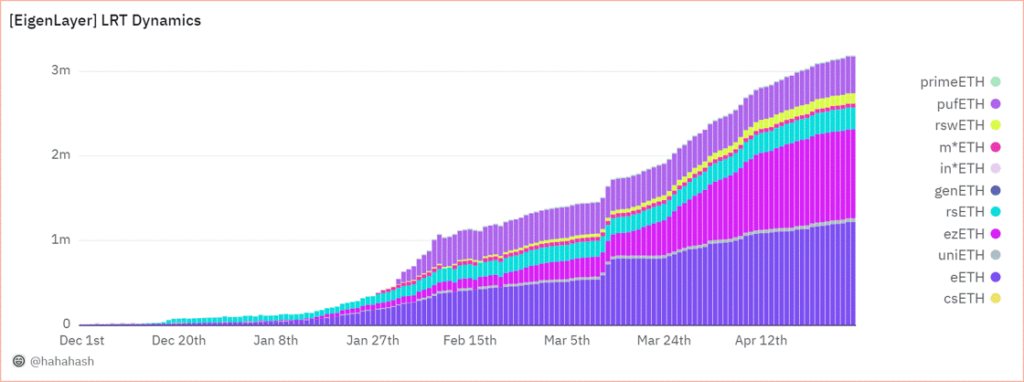
Source: @hahahash on Dune
While LRTs can offer amplified gains through leveraged lending, they can also exacerbate losses, increasing systemic risk in market downturns. Since some LRT protocols can’t offer withdrawals yet, users may be forced to swap their LRT tokens on thinly traded secondary markets, intensifying their decline. Last week, we saw an instance of this risk manifest when Renzo’s ezETH lost its peg. This happened as the ETH derivative experienced heavy selling on various exchanges, causing it to trade at over a 75% discount compared to ETH. This coincided with the company facing scrutiny over its controversial token distribution plan, which is scheduled to launch on April 30.
All in all, the impact of EigenLayer is not to be understated, as the excitement surrounding the new primitive has propelled it to become the second-largest protocol on Ethereum by Total Value Locked (TVL), boasting an impressive $15.6B. This already eclipses the TVL of established players like Solana by fourfold, highlighting the immense adoption that EigenLayer is witnessing despite its brief existence. Further, the excitement building up to its launch since it unveiled its roadmap in March has propelled the Ethereum validator entry queue to its highest level since October. The queue now necessitates a minimum waiting period of 8 days before new validators can join the network, as seen below in Figure 5. Nevertheless, stay tuned as we prepare to release a more in-depth exploration of EigenLayer risks over the coming weeks.
Figure 5: Ethereum Validator Entry Queue in Days

Source: ValidatorQueue
Next Month’s Calendar

Source: Forex Factory, 21Shares
Research Newsletter
Each week the 21Shares Research team will publish our data-driven insights into the crypto asset world through this newsletter. Please direct any comments, questions, and words of feedback to research@21shares.com
Disclaimer
The information provided does not constitute a prospectus or other offering material and does not contain or constitute an offer to sell or a solicitation of any offer to buy securities in any jurisdiction. Some of the information published herein may contain forward-looking statements. Readers are cautioned that any such forward-looking statements are not guarantees of future performance and involve risks and uncertainties and that actual results may differ materially from those in the forward-looking statements as a result of various factors. The information contained herein may not be considered as economic, legal, tax or other advice and users are cautioned to base investment decisions or other decisions solely on the content hereof.
Nyheter
ETC Group lanserar BTC1, En unik Core Bitcoin ETP
Publicerad
24 timmar sedanden
1 maj, 2024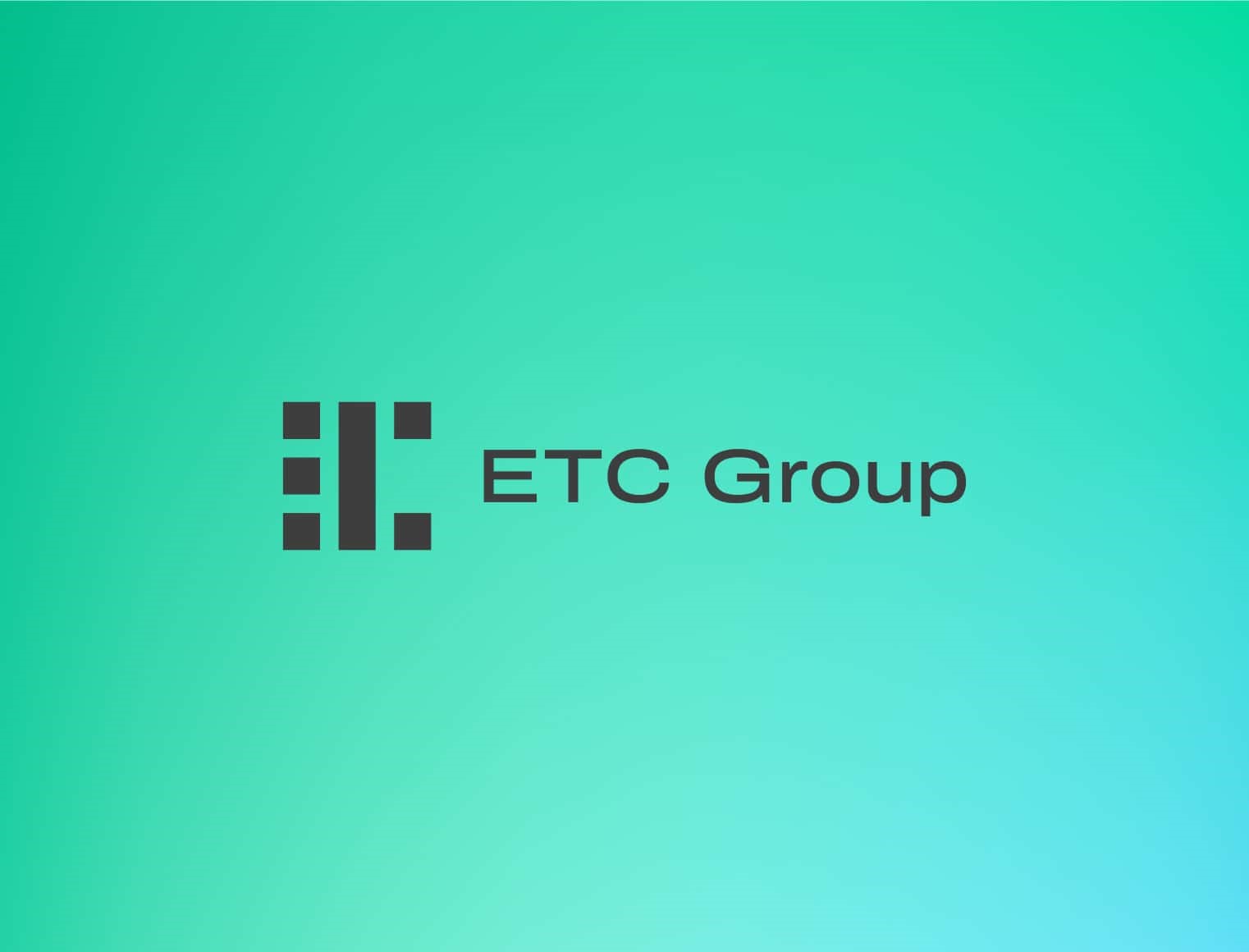
BTC1 är en bäst-i-klassen Bitcoin ETP utformad för benchmark-fokuserade långsiktiga investerare. ETC Group tillkännagav i förra veckan lanseringen av sin senaste börshandlade produkt (ETP) på Deutsche Börse XETRA. ETC Group Core Bitcoin ETP (ticker BTC1; ISIN DE000A4AER62) som har skräddarsytts specifikt för benchmarkmedvetna, långsiktiga köp-och-håll-investerare och globala institutionella investerare med utökade behov av likviditet och riskhantering. BTC1 kompletterar ETC Groups befintliga produktsortiment, som bland annat inkluderar den mest likvida och största krypto-ETP i Europa.
Viktiga höjdpunkter
- Kostnadseffektiv: Med en Total Expense Ratio (TER) på 0,30 % erbjuder BTC1 en konkurrensfördel i kostnadseffektivitet.
- Benchmark-fokuserad: BTC1 spårar det institutionella prisindexet för Bitcoin med CF Benchmarks, vilket säkerställer noggrannhet och tillförlitlighet vid spårning av Bitcoins prisrörelser.
- Bredare och bredare primärmarknadslikviditet: Som den första reglerade globala spot-Bitcoin-produkten tillhandahåller BTC1 oöverträffad primärmarknadslikviditet, och överbryggar USA, Europa och Asien spot-BTC-likviditet under de handelsfönster som används av globalt, reglerat institutionellt kapital.
- Tri-NAV-metodik: BTC1 introducerar en unik Tri-NAV-metodik, som erbjuder institutionella investerare ett utökat likviditetsfönster på primärmarknaden som täcker amerikanska, europeiska och asiatiska BTC-spotlikviditeter. Därför tillhandahåller emittenten, förutom börsens öppettider, tre prisbestämningar under dagen (istället för bara en) för att utöka den primära marknadens likviditet över ytterligare tidszoner. Detta innebär att institutionella investerare kan handla med sina innehav under den längsta perioden jämfört med alla andra reglerade Bitcoin spotinstrumement över hela världen på den primära marknaden. Som ett resultat kan BTC1 betraktas som den första globalt orienterade Bitcoin-spot-ETP.
- Robust ETP-struktur: BTC1 använder samma betrodda produktstruktur som ETC Groups övriga produkter, inklusive tysk hemvist med primär notering på XETRA, 100 % fysisk uppbackning och full fungibilitet med det underliggande. Dessutom har BTC1 också en oberoende administratör, ett unikt ETP-strukturattribut som först introducerades av ETC Group 2020. Denna administratörsenhet har laglig vetorätt på alla tillgångar eller värdepappersrörelser hos ETP-utgivaren, övervakar depåbalanser och lägger totalt sett till ett extra lager säkerhet för emittentens produktekosystem.
- Säker förvaringslösning: Tillgångar förvaras säkert hos Zodia Custody, en ledande europeisk institutionell leverantör av kylförvaring, med ett ramverk för efterlevnad och styrning av bankklass.
Varför benchmark och likviditet spelar roll
Bitcoins likviditet är enorm men fragmenterad över flera börser, vilket komplicerar prisbestämningen för investerare. CF Benchmarks har utvecklat det mest robusta riktmärket för att fånga och aggregera denna likviditet, BRR-indexet och dess amerikanska och asiatiska varianter – BRRY och BRRAP som tillsammans har blivit det mest använda riktmärket som används av reglerat institutionellt kapital, inklusive majoriteten av amerikanska spot-ETFer och CME Futures. BTC1 utnyttjar alla tre regionala varianter av detta riktmärke, vilket gör att institutionella investerare kan spåra Bitcoins rättvisa pris exakt och säkert. I slutändan, ger tillgång till tre likviditetspooler/värderingspoäng under 14 timmar (jämfört med värderingspunkt och ett 8-timmarsfönster för alla andra ETFer och ETPer globalt).
BTC1 tar itu med de likviditetsutmaningar som institutionella investerare står inför med befintliga Bitcoin ETPer, som är begränsade till traditionella börstider. Med Bitcoin-handel dygnet runt och Bitcoin Futures-handel 23/5, erbjuder BTC1 institutionella investerare en global och reglerad spot Bitcoin ETP, med för närvarande den bredaste primära marknadslikviditeten för Bitcoin ETPer globalt. Detta utökade likviditetsfönster förbättrar pristransparens och riskhanteringsförmåga för institutionella investerare.
Chanchal Samadder, produktchef på ETC Group, kommenterade, BTC1 representerar en betydande milstolpe i utvecklingen av Bitcoin-investeringsprodukter. Designad med benchmarkmedvetna och långsiktiga investerare i åtanke, erbjuder BTC1 en unik blandning av kostnadseffektivitet, noggrannhet och utökad primärmarknadslikviditet, vilket sätter en ny standard på Bitcoin ETP-marknaden.
Banar kontinuerligt vägen som Tysklands första Crypto ETP-utgivare
Tim Bevan, VD kommenterade: På ETC Group vill vi driva kryptoinvesteringsbranschen framåt och lanseringen av BTC1 representerar ett unikt förslag. Med BTC1 tar vi ut den första globalt orienterade Bitcoin ETP på marknaden, med de utökade funktioner för likviditet och riskhantering som våra kunder behöver. Vi är stolta över att lansera ännu en marknad först och vi tror att BTC1 har potentialen att unikt betjäna institutionella investerare med klassens bästa egenskaper.
BTC1 kommer att kunna handlas på XETRA och många andra plattformar och kommer att läggas till HANetfs paneuropeiska ETP-distributionsplattform.
Nya tillägg till ETC Groups institutionella produktsortiment inkluderar ET32, den unika totalavkastningen Ethereum-satsning ETP kopplad till ett transparent insatsriktmärke, och DA20, den enda breda marknaden Crypto Basket ETP som spårar ett MSCI-riktmärke för digitala tillgångar bland de 20 bästa kryptovalutorna som det går att investera i.

XEMC ETF investerar i klimatförändrare i emerging markets

Regulatory Crackdowns and Ethereum’s Most Anticipated Application

ETC Group lanserar BTC1, En unik Core Bitcoin ETP

LITM ETF ger exponering mot litium och batterier

Ombalansering av Valour Digital Asset Basket 10 (VDAB10) inkluderar Toncoin och Shiba Inu Coin

ETFmarknaden i Europa firar sitt 24-årsjubileum med tillgångar på två biljoner USD

Tillgång till obligationsmarknaden för företagsobligationer från utvecklade marknader

Vilken är den bästa fond som följer Nasdaq-100?

Försvarsfond når förvaltad volym på 500 MUSD

Vad händer härnäst för Bitcoin?
Populära
-

 Nyheter2 veckor sedan
Nyheter2 veckor sedanETFmarknaden i Europa firar sitt 24-årsjubileum med tillgångar på två biljoner USD
-

 Nyheter2 veckor sedan
Nyheter2 veckor sedanTillgång till obligationsmarknaden för företagsobligationer från utvecklade marknader
-

 Nyheter4 dagar sedan
Nyheter4 dagar sedanVilken är den bästa fond som följer Nasdaq-100?
-

 Nyheter3 veckor sedan
Nyheter3 veckor sedanFörsvarsfond når förvaltad volym på 500 MUSD
-
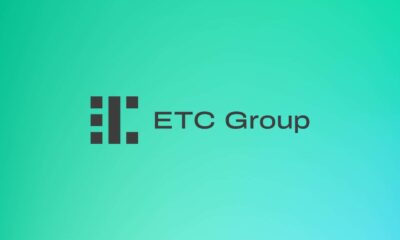
 Nyheter4 veckor sedan
Nyheter4 veckor sedanVad händer härnäst för Bitcoin?
-

 Nyheter3 dagar sedan
Nyheter3 dagar sedanDe mest populära börshandlade fonderna april 2024
-

 Nyheter4 veckor sedan
Nyheter4 veckor sedanNy börshandlad fond från Deka ger tillgång till S&P 500-index
-

 Nyheter3 veckor sedan
Nyheter3 veckor sedanBygg din egen pengamaskin



